Fault Injection with Multiple Fault Patterns for Experimental Evaluation of Demand-Controlled Ventilation and Heating Systems
Abstract
1. Introduction
2. Related Work
2.1. Fault Injection in HVAC Systems
2.2. Experimental Evaluation in HVAC Systems
2.3. Multiple Faults in HVAC Systems and Other Domains
2.4. Fault Occurrence Probabilities in HVAC Systems
2.5. Research Gap and Contributions Discussion
2.5.1. Modeling Patterns of Multiple Faults in DCV and Heating Systems Based on Data from Field Failure Rates and Maintenance Records
2.5.2. Injecting Multiple Faults into a DCV and Heating System
2.5.3. Experimentally Evaluating the Effects of Multiple Faults on the Behavior of DCV and Heating Systems
3. System Model
3.1. HVAC Systems
3.2. Fault Classifications in HVAC Systems
- Developmental Faults: A developmental fault occurs before the equipment installation. Developmental faults can be physical faults in production (e.g., inaccurate mask alignment) or design faults (e.g., incorrect positioning of sensors, improper scheduling of operations).
- Operational Faults: An operational fault occurs after the equipment installation phase. An example is wear out electronic components.
3.3. Fault Injection Framework for Multiple Component Faults
3.3.1. Fault Model
- x represents healthy data.
- x’ calculates faulty data.
- β is the coefficient of gain faults.
- α is the coefficient of offset faults.
| Nr. | Fault Attributes | Descriptions |
|---|---|---|
| 1 | Fault type | Offset, gain, stuck-at, out of bounds, data loss, and white noise |
| 2 | Fault persistence | Short intermittent, and permanent |
| 3 | Fault duration | Fault presence period |
| 4 | Fault interarrival time | The time interval between faults |
| 5 | Fault location | Temperature sensor, CO2 concentration sensor, damper actuator, heater actuator |
| 6 | Fault occurrence rate | Probability of occurrence in case of each fault type |
| 7 | System fault repetition | Number of repetitions in case of each intermittent FI |
Fault Types in HVAC Systems
- Offset fault: A shift value that adds to the actual sensed data due to sensing units’ bias/drift/calibration error. This fault has only been considered for the sensors.
- Gain fault: A gain fault occurs once the change rate of sensed data is different from the expected rate. This fault has only been considered for the sensors.
- Stuck-at fault: Stuck-at faults may happen in both actuators and sensors as stuck-at sensed values, stuck-at closed status in damper actuators, and stuck-at-off in heater actuators.
- Out-of-bounds fault: There are maximum and minimum bounds for each sensor, and sensor measurements should be in these ranges. There is an out-of-bounds fault when the observed values are out of the bounds of the expected values.
- White noise fault: A random number is added to the value, which is determined by Gaussian or uniform probability distributions [8].
- Data loss fault: There is missing data during a specific time interval. In case of a data loss fault, the last measurement of the sensed data indicates that the actual measurement is missed.
Fault Persistence in HVAC Systems
- Short and long intermittent faults: Permanent and transient faults differ from intermittent faults, and few fault models describe intermittent faults with their occurrence frequencies [47,49,50,51,52,57]. Therefore, there is no reliable timing model for intermittent faults for the sensors in HVAC systems. Intermittent faults are more common in actuators. The timing parameters in the literature have been applied in our fault model [8,58,59]. Short intermittent faults have limited the fault repetitions to two repetitions. In the case of long intermittent faults, repetitions can increase based on the designer’s necessities, but faults also disappear eventually. In this paper, intermittent faults have been considered only for the actuators due to the lack of proper timing models for the sensors in HVAC systems.
- Permanent fault: For sensors and actuators, permanent faults have been considered during the FI process. After activation, permanent faults remain in the system for the rest of the execution time.
Fault Occurrence Rate in HVAC Systems
- Fault Occurrence Probabilities in HVAC Systems
4. Implementation and Simulation
4.1. Implementation
4.2. Simulation
5. Evaluation and Data Analysis for Multiple Faults
5.1. Scenario Generation
| Algorithm 1 Fault Object Generator Class |
| Classdef Fault Object Generator properties Activated_Room_component_Combination_Matrix; //Activation of the faulty rooms and components including subevents Fault_Injection_Persistence_Matrix; //Assigning the FI persistence for faulty components Fault_Injection_Time_Matrix; //Assigning the FI time types Fault_Injection_Duration_Matrix; //Assigning the FI duration times Fault_Injection_Interarrival_Matrix; //Assigning the FI interarrival times Fault_Injection_Type_Matrix; //Assigning the FI types for faulty components Fault_Occurrence_Probability_Matrix; //calculating the FI types for faulty components Faulty_SystemOutput; //Storing faulty output for each fault case, including system signals Fault_Repetitions; //Assigning the number of repetitions for each subevent end end |
5.2. Evaluation and Results
5.2.1. Results
Multiple FI in Multiple Components in One Zone (Two Intermittent Stuck-at Faults in Heater Actuator and One Permanent Offset Fault in CO2 Sensor)
Multiple FI in Multiple Components in One Zone (Two Intermittent Stuck-at Faults in Damper Actuator and one Permanent Stuck-at Fault in Temperature Sensor)
Multiple Fault Injection in One Component (Intermittent Fault in Heater Actuator with 10 Repetitions)
6. Conclusions
7. Future Works
Author Contributions
Funding
Institutional Review Board Statement
Informed Consent Statement
Data Availability Statement
Conflicts of Interest
References
- Ahmad, M.W.; Mourshed, M.; Yuce, B.; Rezgui, Y. Computational intelligence techniques for HVAC systems: A review. Build. Simul. 2016, 9, 359–398. [Google Scholar] [CrossRef]
- Sala Cardoso, E. Advanced Energy Management Strategies for HVAC Systems in Smart Buildings; Universitat Politècnica de Catalunya: Barcelona, Spain, 2019. [Google Scholar]
- Jagpal, R. Technical synthesis report Annex 34: Computer aided evaluation of HVAC system performance. In Proceedings of the Energy Conservation in Buildings and Community Systems Programme (IEA ECBCS), International Energy Agency; Faber Maunsell Ltd.: Hertfordshire, UK, 2006. [Google Scholar]
- Vishwanath, A.; Hong, Y.-H.; Blake, C. Experimental Evaluation of a Data Driven Cooling Optimization Framework for HVAC Control in Commercial Buildings. In Proceedings of the Tenth ACM International Conference on Future Energy Systems, Phoenix, AZ, USA, 25–28 June 2019; Association for Computing Machinery: New York, NY, USA, 2019; pp. 78–88. [Google Scholar] [CrossRef]
- Ostrý, M.; Bantová, S.; Struhala, K. Compatibility of Phase Change Materials and Metals: Experimental Evaluation Based on the Corrosion Rate. Molecules 2020, 25, 2823. [Google Scholar] [CrossRef]
- Skovajsa, J.; Drabek, P.; Sehnalek, S.; Zalesak, M. Design and experimental evaluation of phase change material-based cooling ceiling system. Appl. Therm. Eng. 2022, 205, 118011. [Google Scholar] [CrossRef]
- Teraoka, H.; Balaji, B.; Zhang, R.; Nwokafor, A.; Narayanaswamy, B.; Agarwal, Y. Buildingsherlock: Fault Management Framework for Hvac Systems in Commercial Buildings; Department of Computer Science and Engineering, University of California University of California: San Diego, CA, USA, 2014. [Google Scholar]
- Kiamanesh, B.; Behravan, A.; Obermaisser, R. Realistic Simulation of Sensor/Actuator Faults for a Dependability Evaluation of Demand-Controlled Ventilation and Heating Systems. Energies 2022, 15, 2878. [Google Scholar] [CrossRef]
- Obermaisser, R.; Peti, P. A fault hypothesis for integrated architectures. In Proceedings of the 2006 International Workshop on Intelligent Solutions in Embedded Systems, Vienna, Austria, 30–30 June 2006; pp. 1–18. [Google Scholar]
- Briones, J.F.; Cabello, M.A.d.; Gallino, J.P.S.; Muñoz, A.A.A. Analysis of Quality Dependencies in the Composition of Software Architectures. In Proceedings of the 13th Jornadas de Tiempo Real, Granada, Spain, 4–5 February 2010. [Google Scholar]
- Karimi, A.; Kiamanesh, B.; Zarafshan, F.; Al-Haddad, S. Markov Process Modeling for Wireless Sensor Network Availability with QOS Constraints. Appl. Mech. Mater. 2013, 330, 1054–1058. [Google Scholar] [CrossRef]
- Behravan, A.; Mallak, A.; Obermaisser, R.; Basavegowda, D.H.; Weber, C.; Fathi, M. Fault injection framework for fault diagnosis based on machine learning in heating and demand-controlled ventilation systems. In Proceedings of the 2017 IEEE 4th International Conference on Knowledge-Based Engineering and Innovation (KBEI), Tehran, Iran, 22–22 December 2017; pp. 273–279. [Google Scholar] [CrossRef]
- Behravan, A.; Obermaisser, R.; Abboush, M. Fault Injection Framework for Demand-Controlled Ventilation and Heating Systems Based on Wireless Sensor and Actuator Networks. In Proceedings of the 2018 IEEE 9th Annual Information Technology, Electronics and Mobile Communication Conference (IEMCON), Vancouver, BC, Canada, 1–3 November 2018; pp. 525–531. [Google Scholar] [CrossRef]
- Jeong, Y.S.; Lee, S.M. A Survey of Fault-Injection Methodologies for Soft Error Rate Modeling in Systems-on-Chips. Bull. Electr. Eng. Inform. 2016, 5, 169–177. [Google Scholar] [CrossRef][Green Version]
- Kooli, M.; di Natale, G. A survey on simulation-based fault injection tools for complex systems. In Proceedings of the 2014 9th IEEE International Conference on Design & Technology of Integrated Systems in Nanoscale Era (DTIS), Santorini, Greece, 6–8 May 2014; pp. 1–6. [Google Scholar]
- Arlat, J.; Aguera, M.; Amat, L.; Crouzet, Y.; Fabre, J.-C.; Laprie, J.-C.; Martins, E.; Powell, D. Fault injection for dependability validation: A methodology and some applications. IEEE Trans. Softw. Eng. 1990, 16, 166–182. [Google Scholar] [CrossRef]
- Elnour, M.A. Fault Diagnosis of Sensor and Actuator Faults In Multi-Zone Hvac Systems. Master’s Thesis, Qatar University Digital Hub, Doha, Qatar, 2019. [Google Scholar]
- Lee, B.; Roh, C.W.; Choi, B.S.; Wang, E.; Ra, H.-S.; Cho, J.; Cho, J.; Shin, H.; Choi, J.W.; Lee, G. Experimental evaluations on the outdoor air-based methods for water saving and plume abatement of cooling tower. Int. J. Low-Carbon Technol. 2020, 15, 421–426. [Google Scholar] [CrossRef]
- Lyu, Y.; Pan, Y.; Yuan, X.; Zhu, M.; Huang, Z.; Kosonen, R. A Comprehensive Evaluation Method for Air-Conditioning System Plants Based on Building Performance Simulation and Experiment Information. Buildings 2021, 11, 522. [Google Scholar] [CrossRef]
- Andrés, M.; Rebelo, F.; Corredera, Á.; Figueiredo, A.; Hernández, J.L.; Ferreira, V.M.; Bujedo, L.A.; Vicente, R.; Morentin, F.; Samaniego, J. Real-Scale Experimental Evaluation of Energy and Thermal Regulation Effects of PCM-Based Mortars in Lightweight Constructions. Appl. Sci. 2022, 12, 2091. [Google Scholar] [CrossRef]
- Directive (eu) 2018/844 of the European Parliament and of the Council of 30 May 2018 Amending Directive 2010/31/eu on the Energy Performance of Buildings and Directive 2012/27/eu on Energy Efficiency. 2018. Available online: https://eur-lex.europa.eu/legal-content/EN/TXT/PDF/?uri=CELEX:32018L0844&from=IT (accessed on 18 August 2022).
- Directive 2010/31/eu of the European Parliament and of the Council of 19 May 2010 on the Energy Performance of Buildings. 2010. Available online: https://eur-lex.europa.eu/LexUriServ/LexUriServ.do?uri=OJ:L:2010:153:0013:0035:en:PDF (accessed on 18 August 2022).
- Antonopoulos, K.; Vrachopoulos, M.; Tzivanidis, C. Experimental evaluation of energy savings in air-conditioning using metal ceiling panels. Appl. Therm. Eng. 1998, 18, 1129–1138. [Google Scholar] [CrossRef]
- Al-Deen, H.N.; Al-Samari, A. Experimental assessment of combining geothermal with conventional air conditioner regardingnergy consumption in summer and winter. Diyala J. Eng. Sci. 2021, 14, 94–107. [Google Scholar] [CrossRef]
- Krajčík, M.; Olesen, B.W.; Petráš, D. Sustainable Heating/Cooling for Low Energy Buildings: Experimental Evaluation of Indoor Environment in Residential Rooms with Different Heating/Cooling Concepts. In Proceedings of the E-nova International Congress 2012: Nachhaltige Gebäude Ansprüche-Anforderungen-Herausforderungen, Pinkafeld, Austria, 22–23 November 2012; pp. 107–114. [Google Scholar]
- Arteconi, A.; Brandoni, C.; Rossi, G.; Polonara, F. Experimental evaluation and dynamic simulation of a ground coupled heat pump for a commercial building. Int. J. Energy Res. 2013, 37, 1971–1980. [Google Scholar] [CrossRef]
- Yalcin, G.; Unsal, O.S.; Cristal, A.; Valero, M. FIMSIM: A fault injection infrastructure for microarchitectural simulators. In Proceedings of the 2011 IEEE 29th International Conference on Computer Design (ICCD), Amherst, MA, USA, 9–12 October 2011; pp. 431–432. [Google Scholar] [CrossRef]
- Stroud, C.E.; Ryan, C.A. Multiple fault simulation with random and clustered fault injection. In Proceedings of the Eighth International Application Specific Integrated Circuits Conference, Austin, TX, USA, 18–22 September 1995; pp. 218–221. [Google Scholar]
- Tarrillo, J.; Tonfat, J.; Tambara, L.; Kastensmidt, F.L.; Reis, R. Multiple fault injection platform for SRAM-based FPGA based on ground-level radiation experiments. In Proceedings of the 2015 16th Latin-American Test Symposium (LATS), Puerto Vallarta, Mexico, 25–27 March 2015; pp. 1–6. [Google Scholar] [CrossRef]
- Kundu, S.; Chattopadhyay, S.; Sengupta, I.; Kapur, R. Multiple Fault Diagnosis Based on Multiple Fault Simulation Using Particle Swarm Optimization. In Proceedings of the 2015 16th Latin-American Test Symposium (LATS), Chennai, India, 2–7 January 2011; pp. 364–369. [Google Scholar] [CrossRef]
- Arlat, J.; Crouzet, Y.; Karlsson, J.; Folkesson, P.; Fuchs, E.; Leber, G. Comparison of physical and software-implemented fault injection techniques. IEEE Trans. Comput. 2003, 52, 1115–1133. [Google Scholar] [CrossRef]
- Zhong, F.; Calautit, J.K.; Wu, Y. Assessment of HVAC system operational fault impacts and multiple faults interactions under climate change. Energy 2022, 258, 124762. [Google Scholar] [CrossRef]
- Sangchoolie, B.; Pattabiraman, K.; Karlsson, J. An Empirical Study of the Impact of Single and Multiple Bit-Flip Errors in Programs. IEEE Trans. Dependable Secur. Comput. 2020, 19, 1988–2006. [Google Scholar] [CrossRef]
- Tadeusiewicz, M.; Halgas, S. An efficient method for simulation of multiple catastrophic faults. In Proceedings of the 2008 15th IEEE International Conference on Electronics, Circuits and Systems, Saint Julian’s, Malta, 31 August–3 September 2008; pp. 356–359. [Google Scholar] [CrossRef]
- Lisboa, C.A.L.; Carro, L. Arithmetic operators robust to multiple simultaneous upsets. In Proceedings of the 19th IEEE International Symposium on Defect and Fault Tolerance in VLSI Systems, Cannes, France, 10–13 October 2004; pp. 289–297. [Google Scholar]
- Papadimitriou, A.; Hély, D.; Beroulle, V.; Maistri, P.; Leveugle, R. A multiple fault injection methodology based on cone partitioning towards RTL modeling of laser attacks. In Proceedings of the 2014 Design, Automation & Test in Europe Conference & Exhibition (DATE), Dresden, Germany, 24–28 March 2014; pp. 1–4. [Google Scholar]
- Wang, H.; Chen, Y.; Chan, C.W.; Qin, J. An online fault diagnosis tool of VAV terminals for building management and control systems. Autom. Constr. 2012, 22, 203–211. [Google Scholar] [CrossRef]
- Takakusagi, A. Analytical study on preventive maintenance of air-conditioning system. J. Arch. Plan. Environ. Eng. (Trans. AIJ) 1991, 430, 45–53. [Google Scholar] [CrossRef][Green Version]
- Kim, Y.C.; Agrawal, V.D.; Saluja, K.K. Multiple faults: Modeling, simulation and test. In ASP-DAC/VLSI Design 2002, Proceedings of the 7th Asia and South Pacific Design Automation Conference and 15h International Conference on VLSI Design, Bangalore, India, 11 January 2002; pp. 592–597. [Google Scholar]
- Dey, D.; Dong, B.; Li, Z. A Probabilistic Framework to Diagnose Faults in Air Handling Units. December 2016. Available online: https://docs.lib.purdue.edu/ihpbc/168/ (accessed on 18 August 2022).
- Li, Y.; O’Neill, Z. A critical review of fault modeling of HVAC systems in buildings. Build. Simul. 2018, 11, 953–975. [Google Scholar] [CrossRef]
- Myrefelt, S. Reliability and Functional Availability of HVAC Systems; Texas A&M University: College Station, TX, USA, 2004. [Google Scholar]
- Otto, K.; Eisenhower, B.; O’Neill, Z.; Yuan, S.; Mezic, I.; Narayanan, S. Prioritizing building system energy failure modes using whole building energy simulation. Proc. SimBuild 2012, 5, 545–553. [Google Scholar]
- Ebrahimifakhar, A. Investigation of the Prevalence of Faults in the Heating, Ventilation, and Air-Conditioning Systems of Commercial Buildings. The University of Nebraska-Lincoln. 2021. Available online: https://www.proquest.com/openview/68d14e0b03e3d16c7270ec2a05c3a8da/1?cbl=18750&diss=y&pq-origsite=gscholar&parentSessionId=0YnH%2BY0a7Ej6gk3qXgDJ7clKavf4TXy%2B3eo%2FRt3UJao%3D (accessed on 18 August 2022).
- Gourabpasi, A.H.; Nik-Bakht, M. Knowledge Discovery by Analyzing the State of the Art of Data-Driven Fault Detection and Diagnostics of Building HVAC. CivilEng 2021, 2, 986–1008. [Google Scholar] [CrossRef]
- Evangeline, C.; Sivamangai, N.M. Evaluation of testability of digital circuits by fault injection technique. In Proceedings of the 2015 2nd International Conference on Electronics and Communication Systems (ICECS), Coimbatore, India, 26–27 February 2015; pp. 92–96. [Google Scholar]
- Chao, W.; Zhongchuan, F.; Hongsong, C.; Gang, C. FSFI: A full system simulator-based fault injection tool. In Proceedings of the 2011 First International Conference on Instrumentation, Measurement, Computer, Communication and Control, Beijing, China, 21–23 October 2011; pp. 326–329. [Google Scholar]
- Behravan, A. Diagnostic Classifiers Based on Fuzzy Bayesian Belief Networks and Deep Neural Networks for Demand-Controlled Ventilation and Heating Systems. Available online: https://dspace.ub.uni-siegen.de/handle/ubsi/2154 (accessed on 20 August 2022).
- Bondavalli, A.; Chiaradonna, S.; Di Giandomenico, F.; Grandoni, F. Threshold-based mechanisms to discriminate transient from intermittent faults. IEEE Trans. Comput. 2000, 49, 230–245. [Google Scholar] [CrossRef]
- Ahmad, W.S.; Perinpanayagam, S.; Jennions, I.; Khan, S. Study on Intermittent Faults and Electrical Continuity. Procedia CIRP 2014, 22, 71–75. [Google Scholar] [CrossRef]
- Constantinescu, C. Intermittent faults and effects on reliability of integrated circuits. In Proceedings of the 2008 Annual Reliability and Maintainability Symposium, Las Vegas, NV, USA, 28–31 January 2008; pp. 370–374. [Google Scholar] [CrossRef]
- Rashid, L.; Pattabiraman, K.; Gopalakrishnan, S. Intermittent hardware errors recovery: Modeling and evaluation. In Proceedings of the 2012 Ninth International Conference on Quantitative Evaluation of Systems, London, UK, 17–20 September 2012; pp. 220–229. [Google Scholar]
- Torabi, N.; Gunay, H.B.; O’Brien, W. A review of common human errors in design, installation, and operation of multiple-zone VAV AHU systems. J. Phys. Conf. Ser. 2021, 2042. [Google Scholar] [CrossRef]
- Frank, S.M.; Kim, J.; Cai, J.; Braun, J.E. Common Faults and Their Prioritization in Small Commercial Buildings: February 2017–December 2017; National Renewable Energy Lab. (NREL): Golden, CO, USA, 2018. [Google Scholar] [CrossRef]
- Chen, Y.; Lin, G.; Crowe, E.; Granderson, J. Development of a Unified Taxonomy for HVAC System Faults. Energies 2021, 14, 5581. [Google Scholar] [CrossRef]
- Haves, P. Fault modelling in component-based HVAC simulation. In Proceedings of the Building Simulation ’97. 1997. Available online: http://www.ibpsa.org/%5Cproceedings%5CBS1997%5CBS97_P101.pdf (accessed on 18 August 2022).
- McDowall, R. Fundamentals of HVAC Systems, SI ed.; Academic Press: Cambridge, MA, USA, 2007. [Google Scholar]
- Non-Directional Intermittent Ground Fault Protection. Available online: https://www.webgreenstation.com/non-directionalintermittent-ground-fault-protection-siprotec-5-siemens-si5034/ (accessed on 13 January 2022).
- Kuflom, M.; Crossley, P.; Liu, N.L.N. Impact of pecking faults on the operating times of numerical and electromechanical over-current relays. IET 2016. [Google Scholar] [CrossRef]
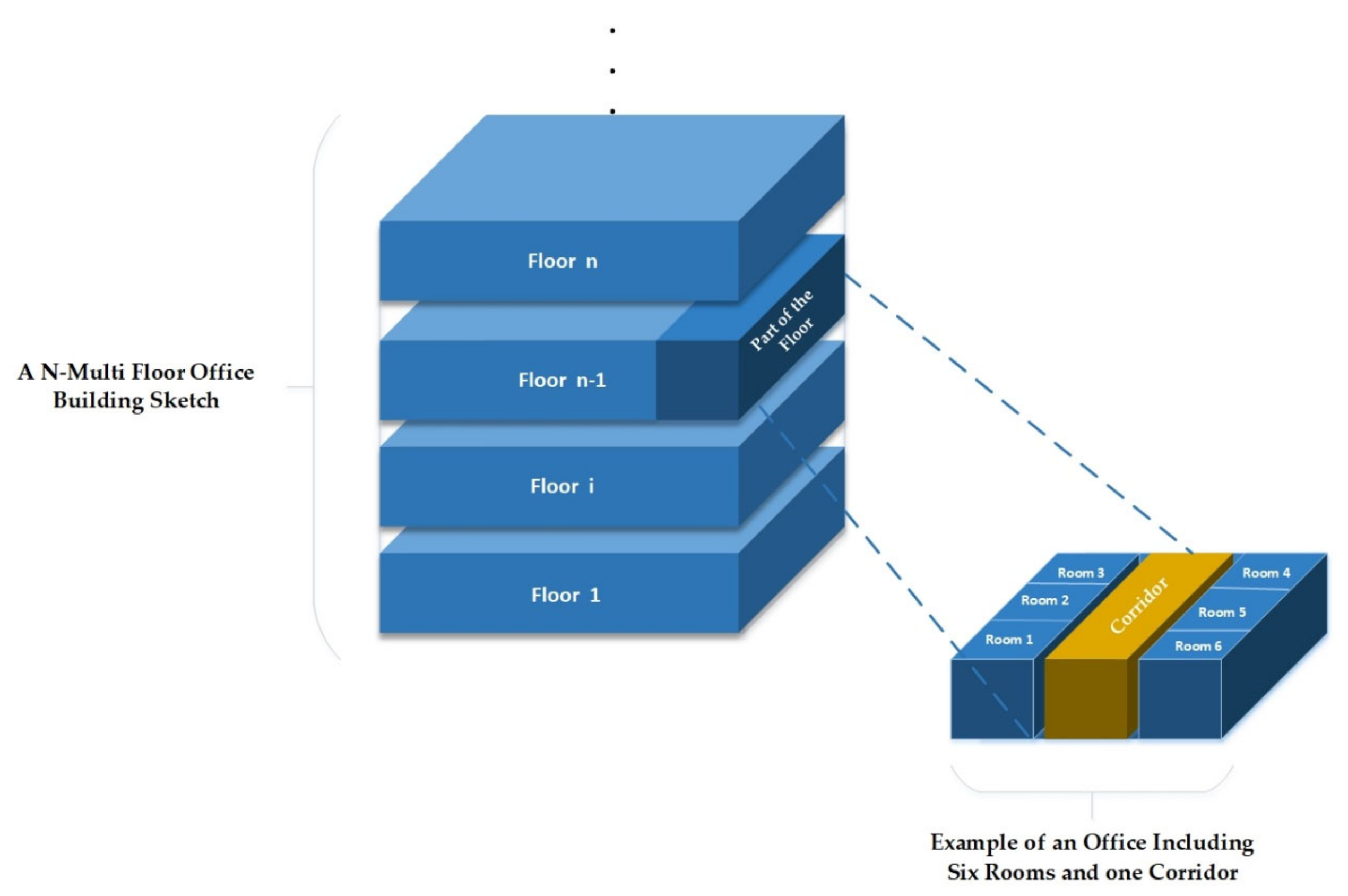
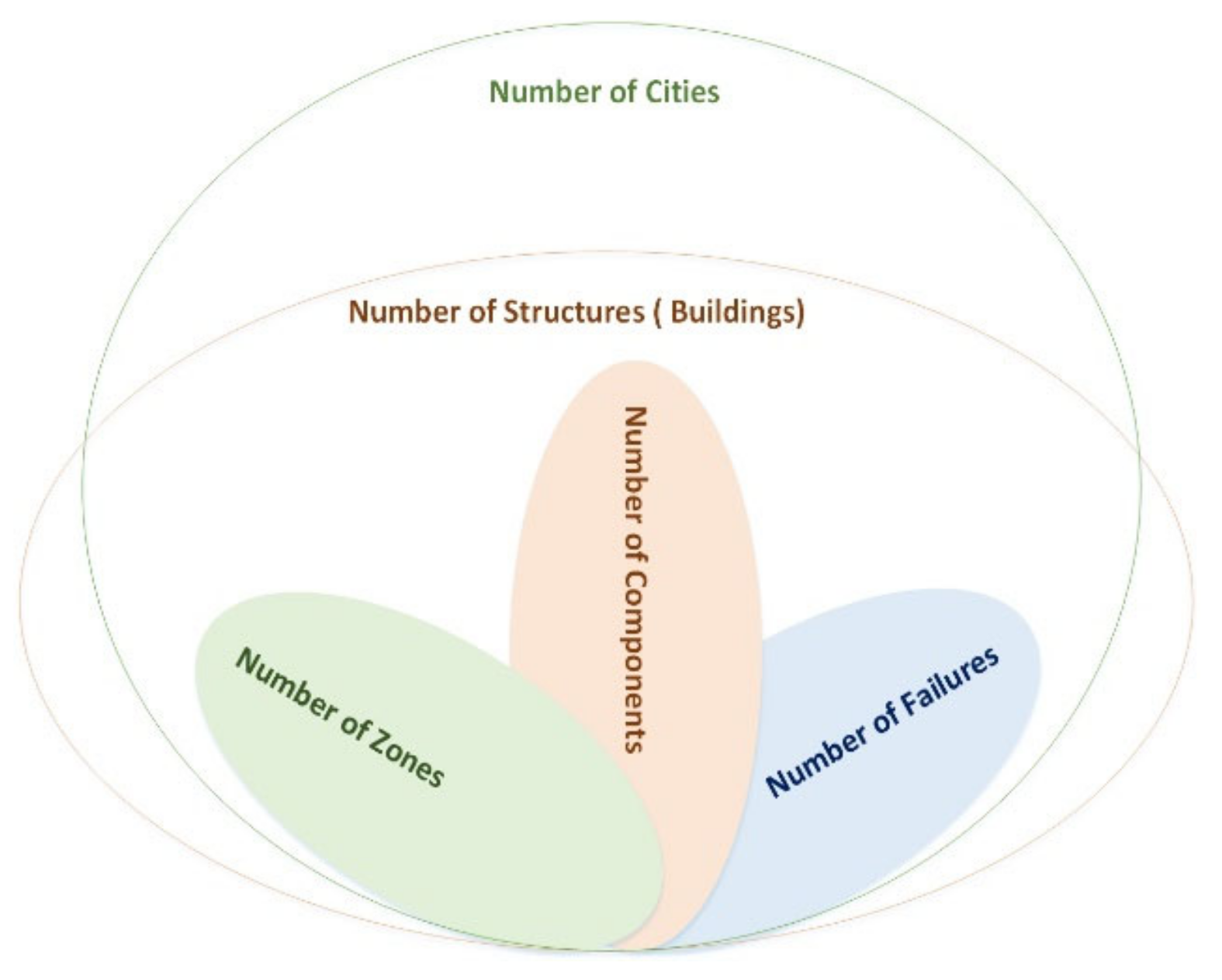
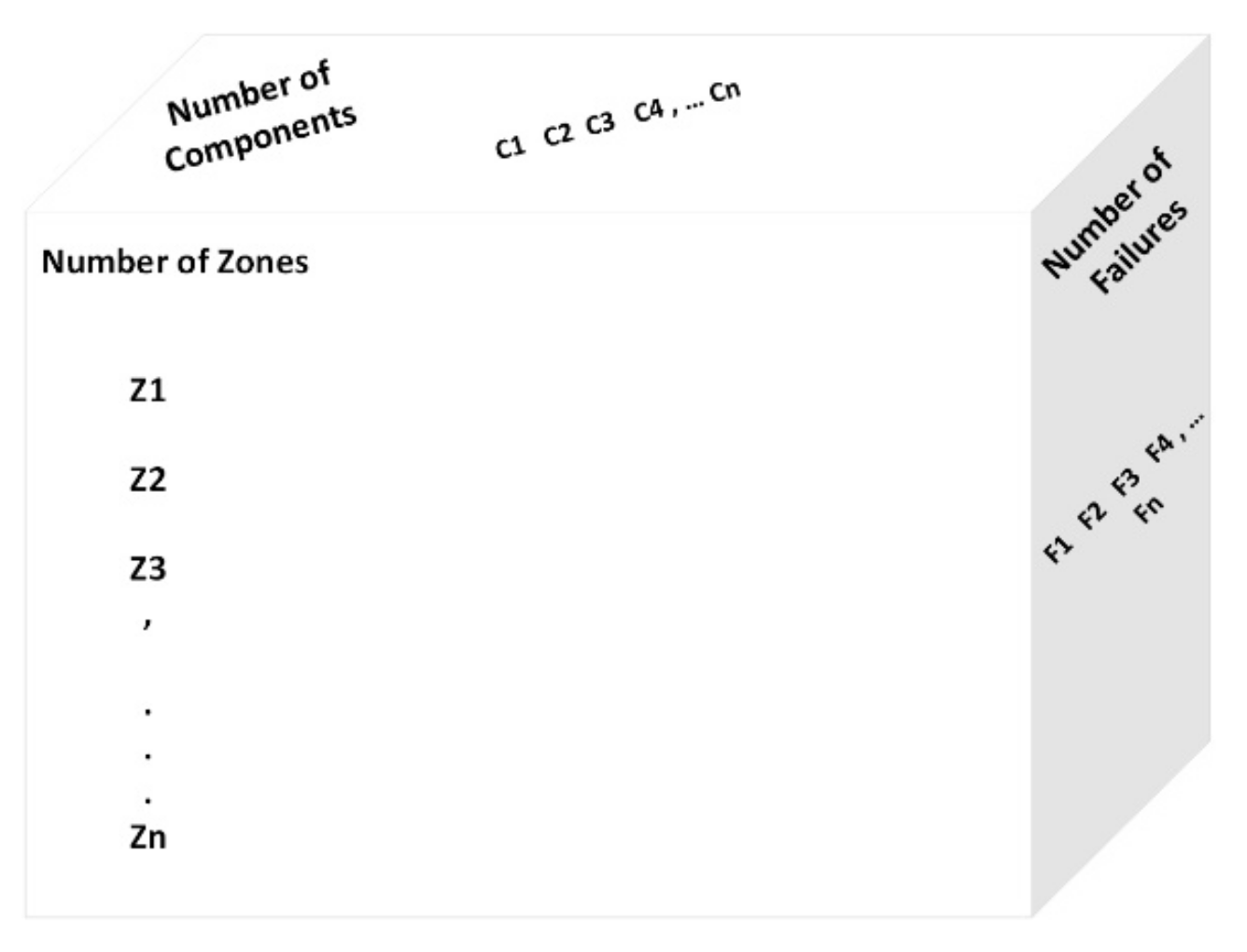
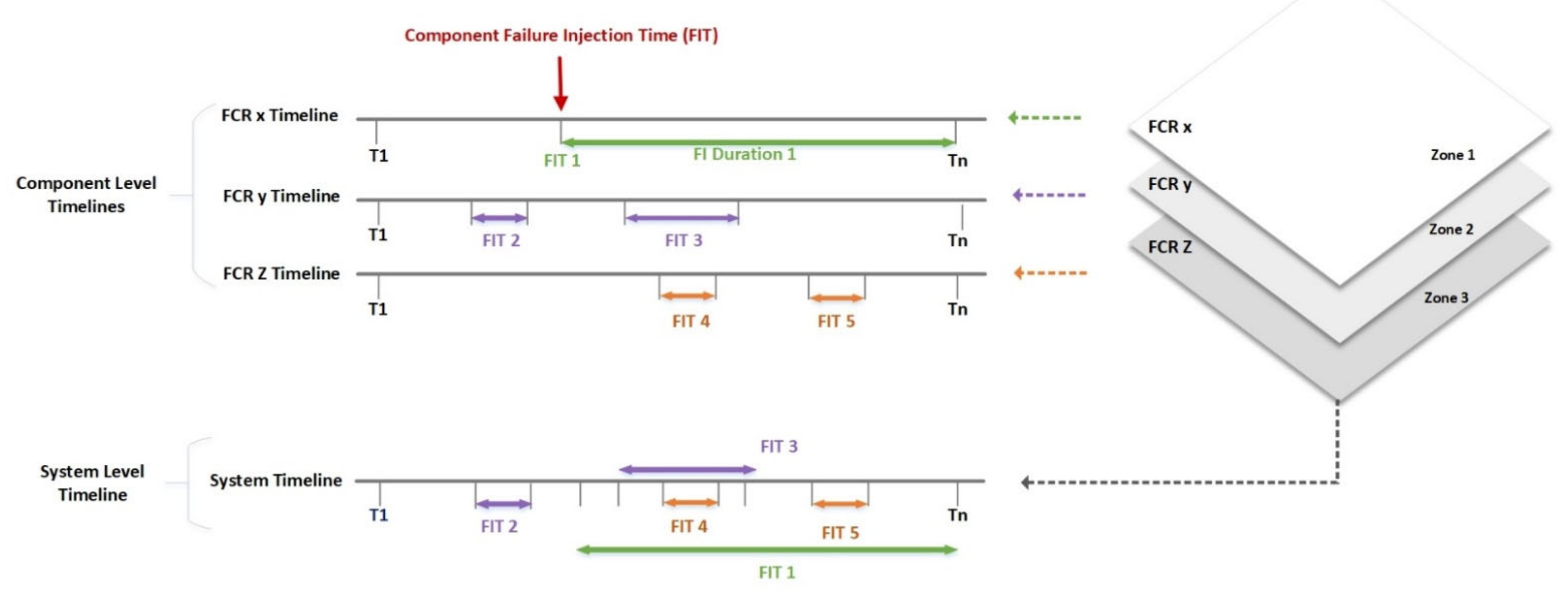


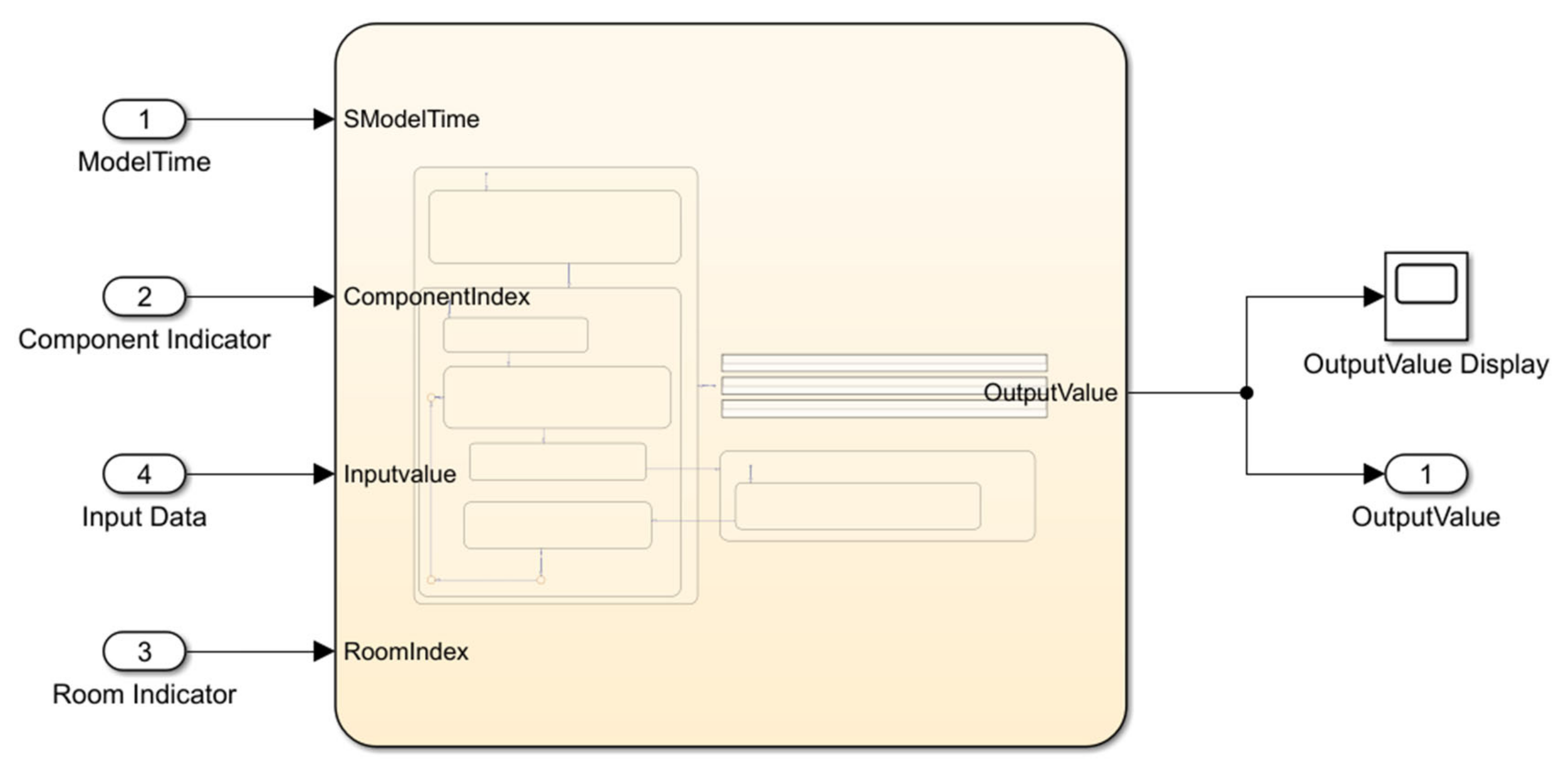
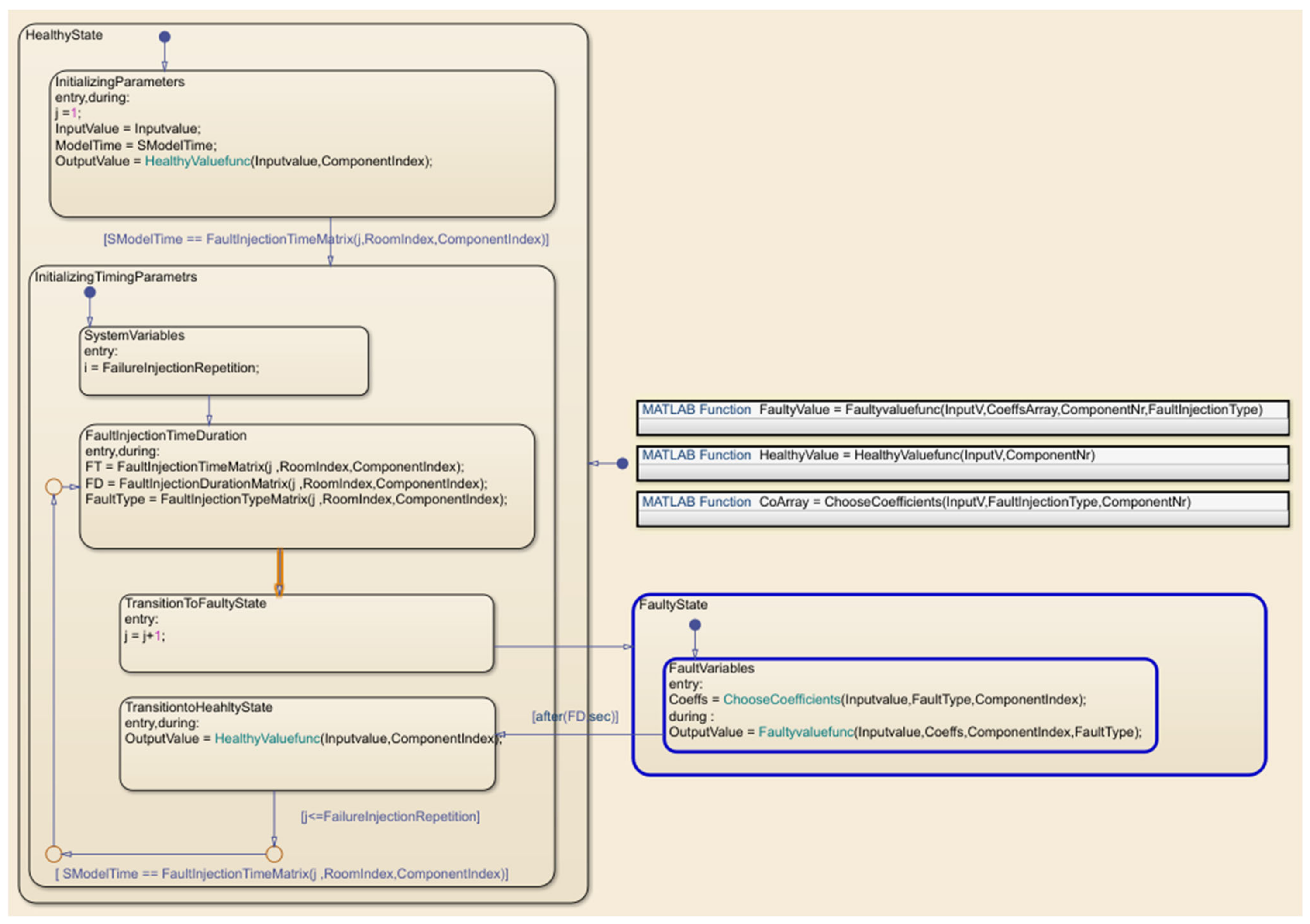

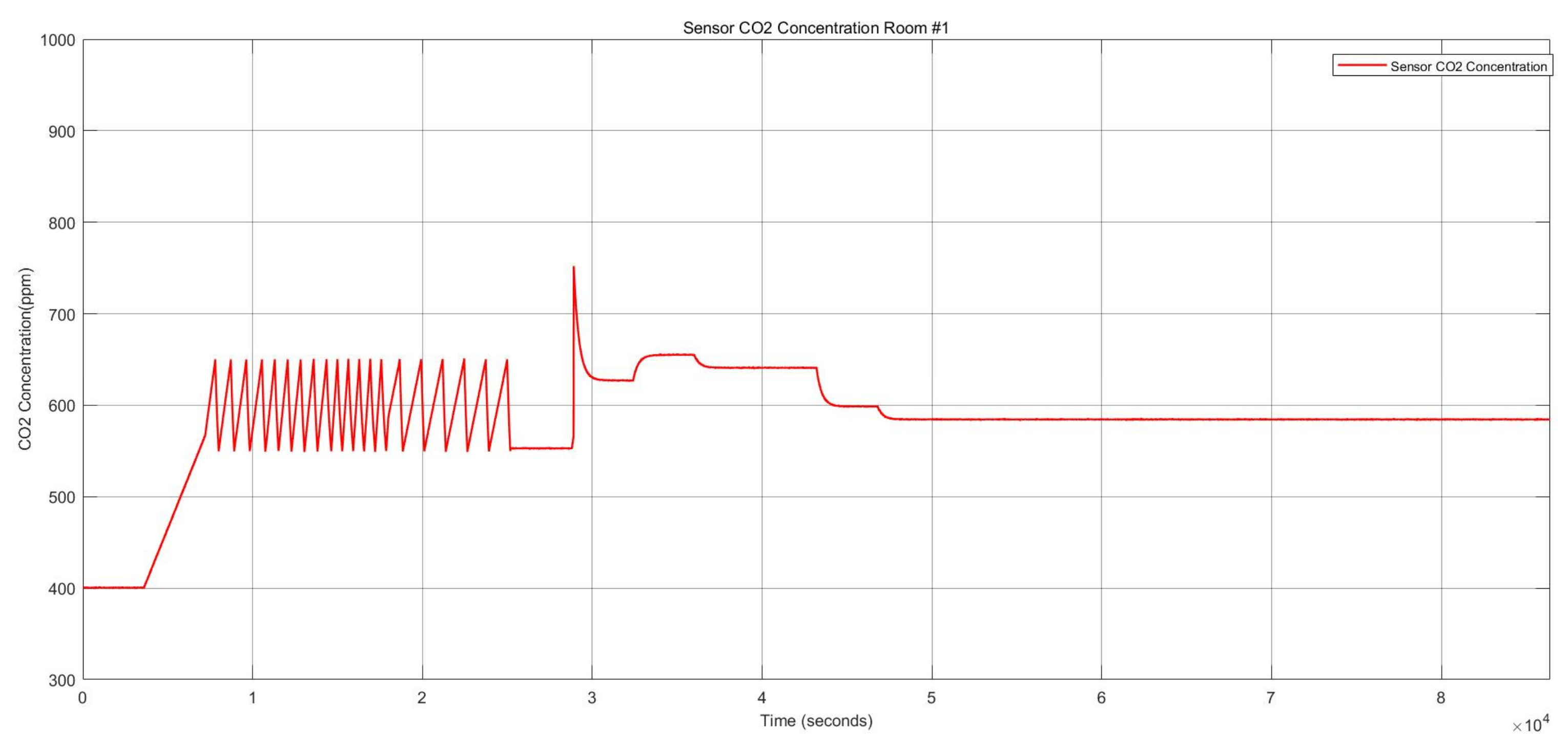


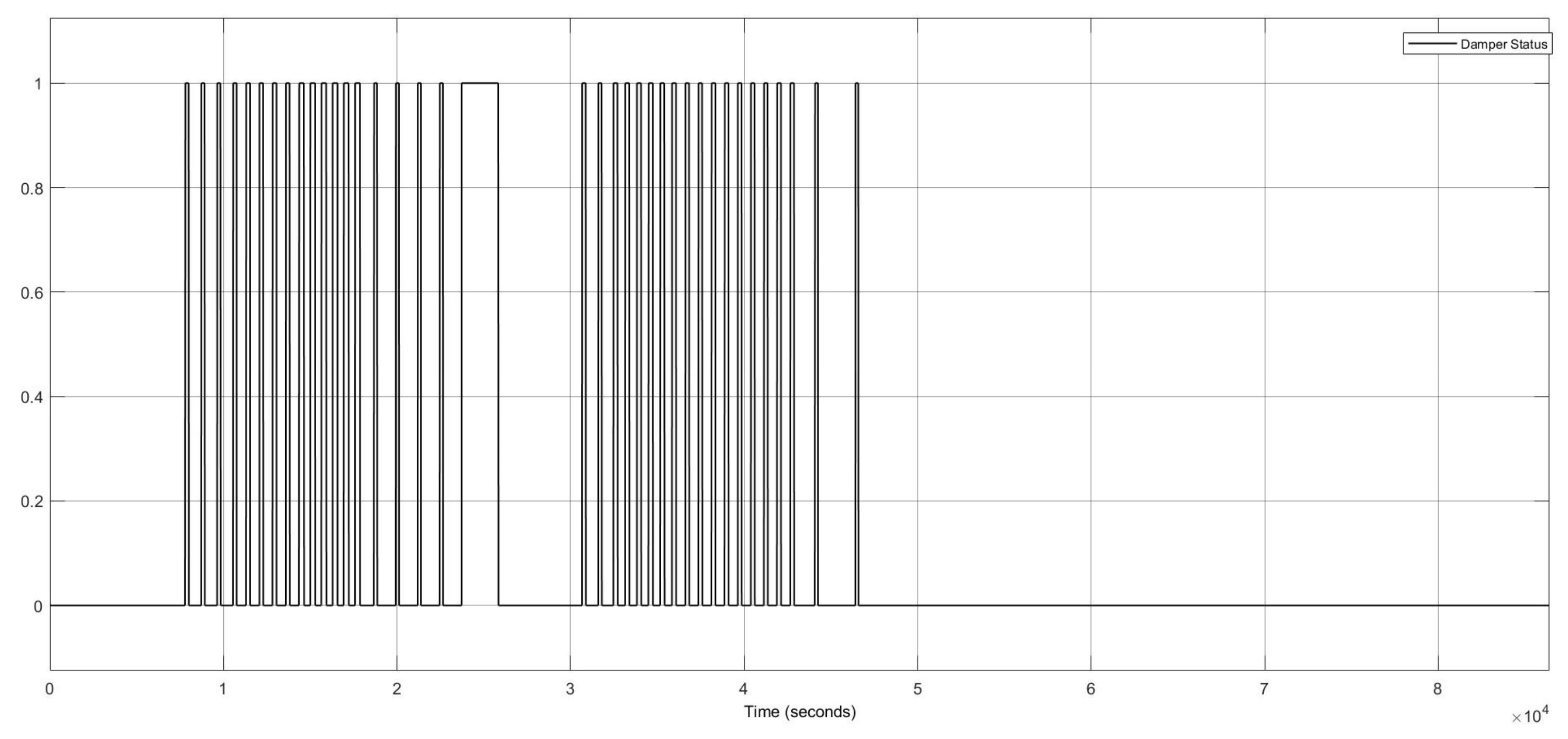
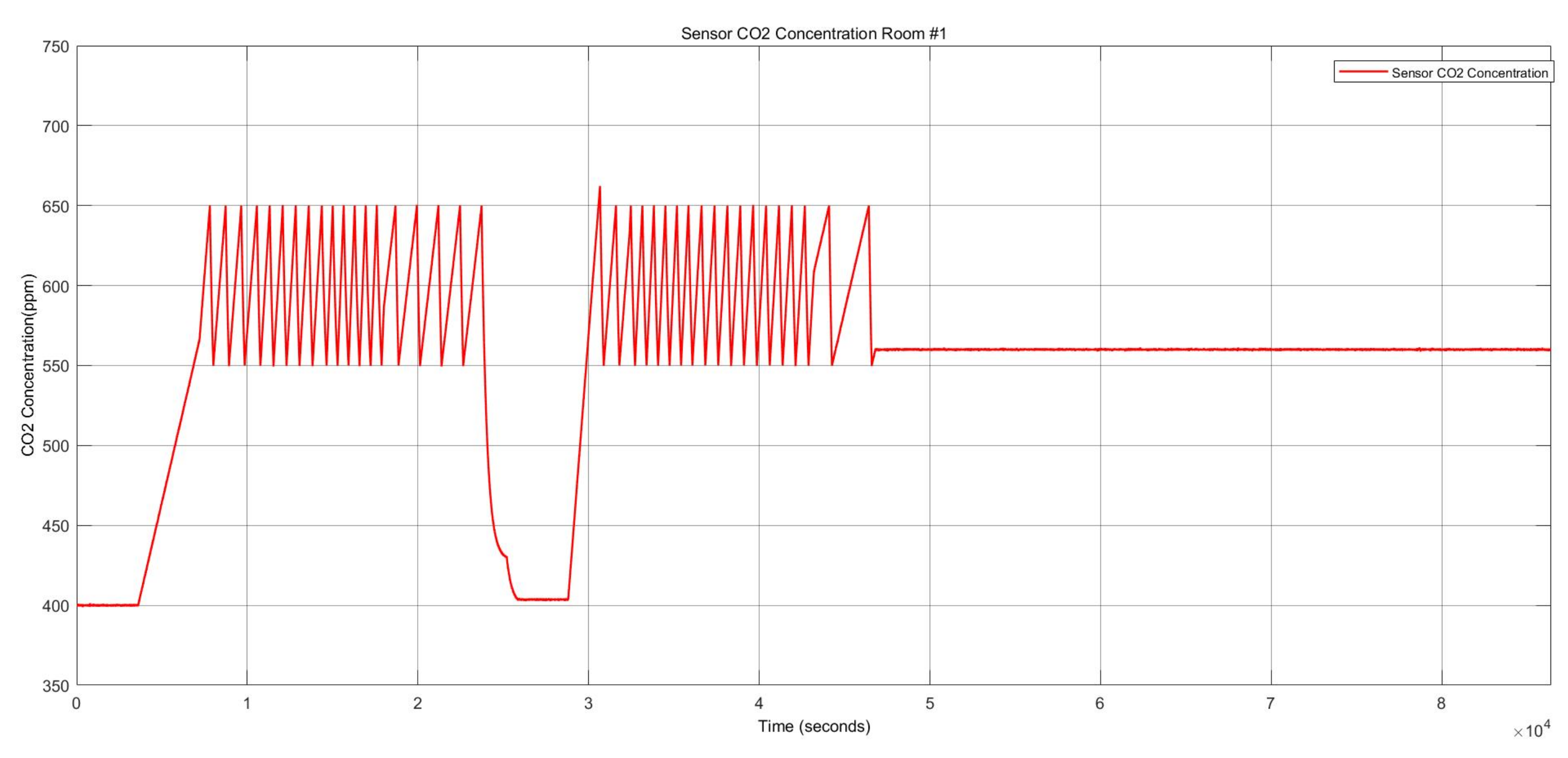
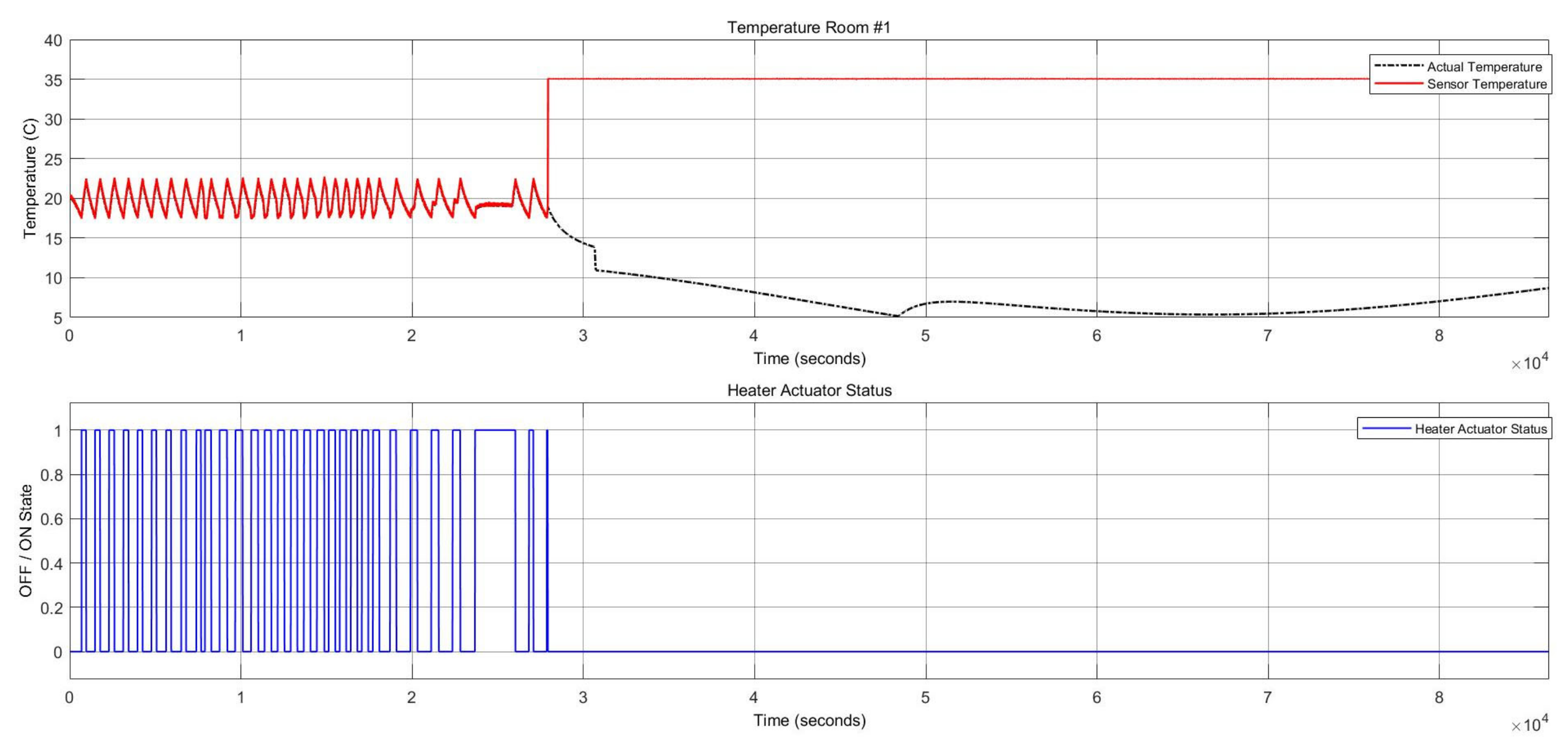
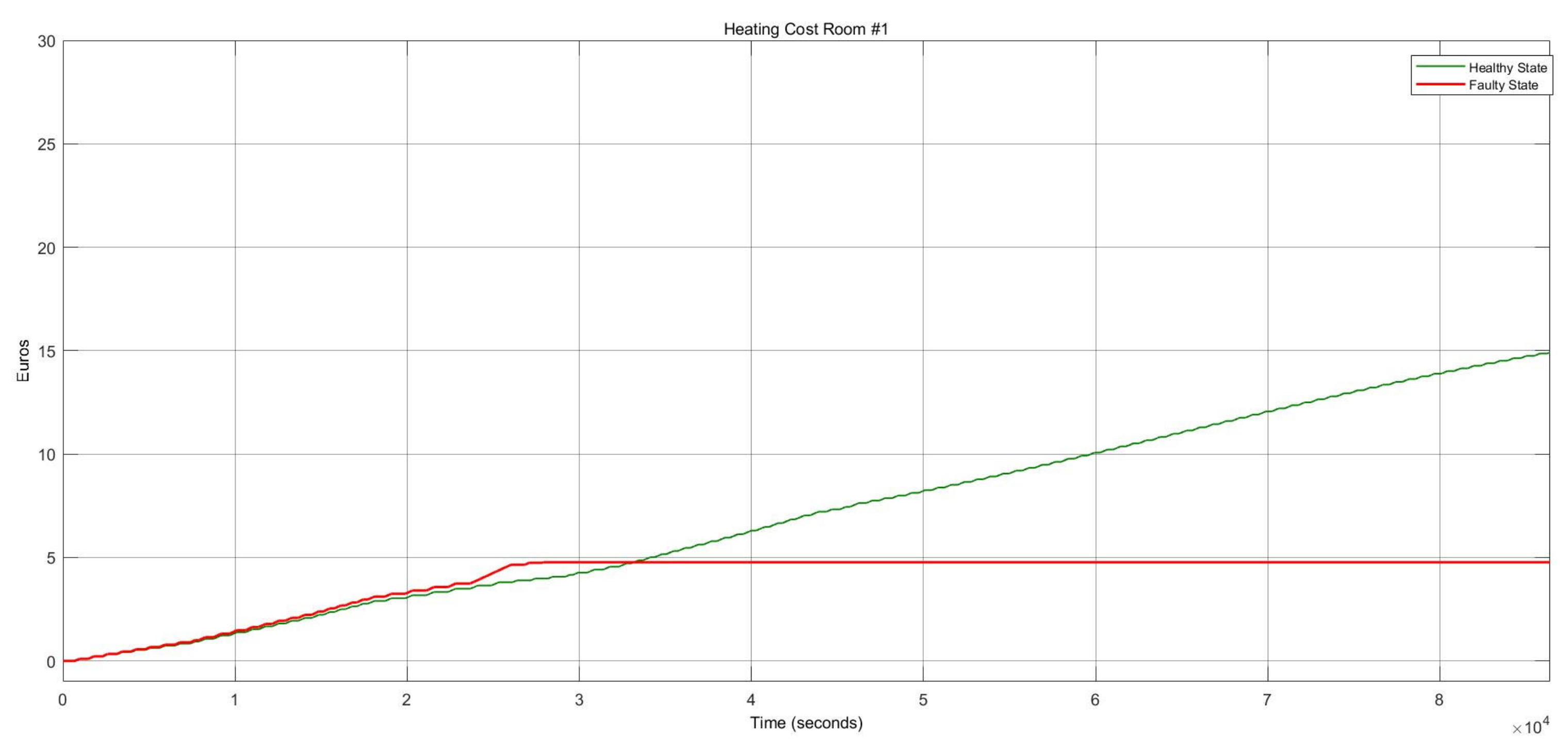
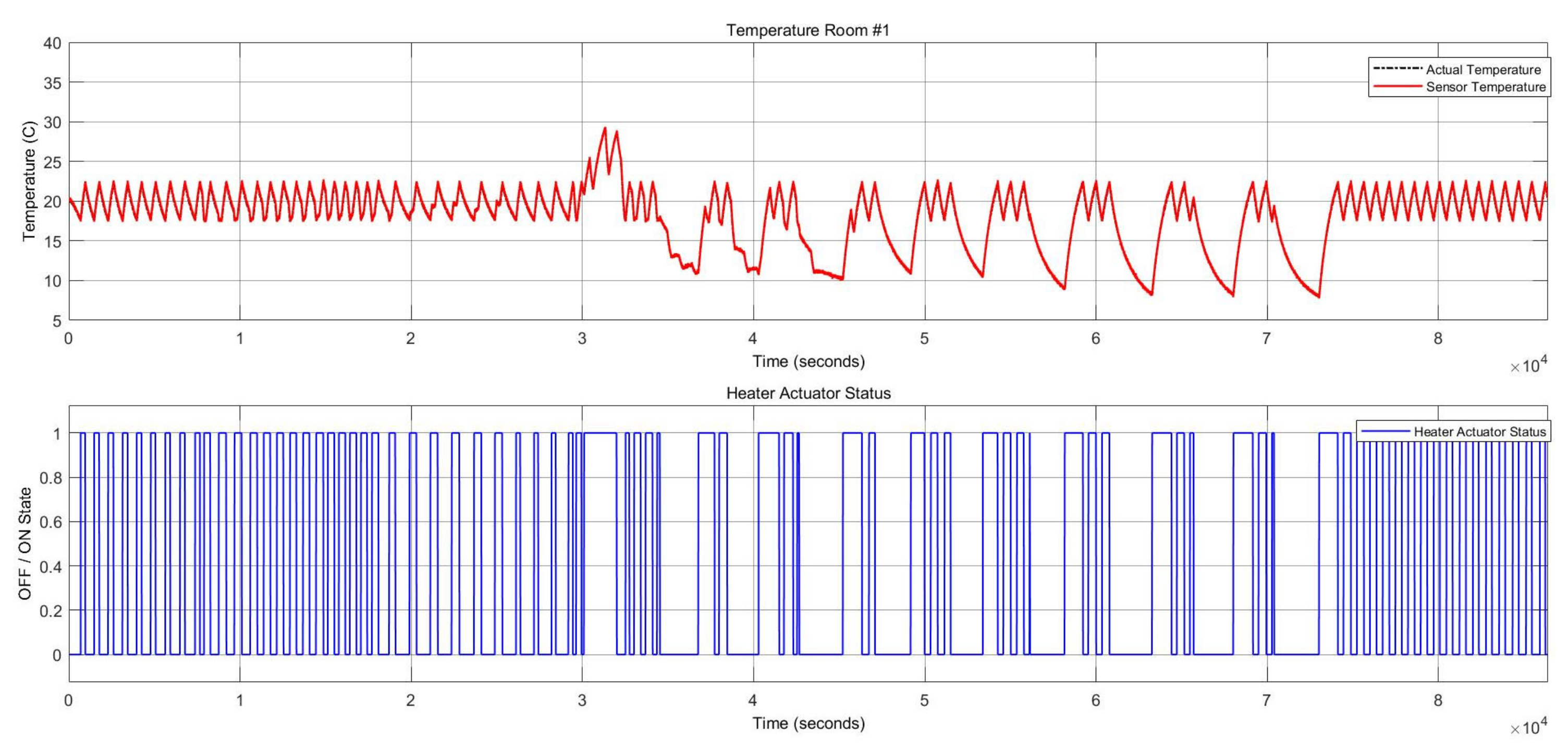
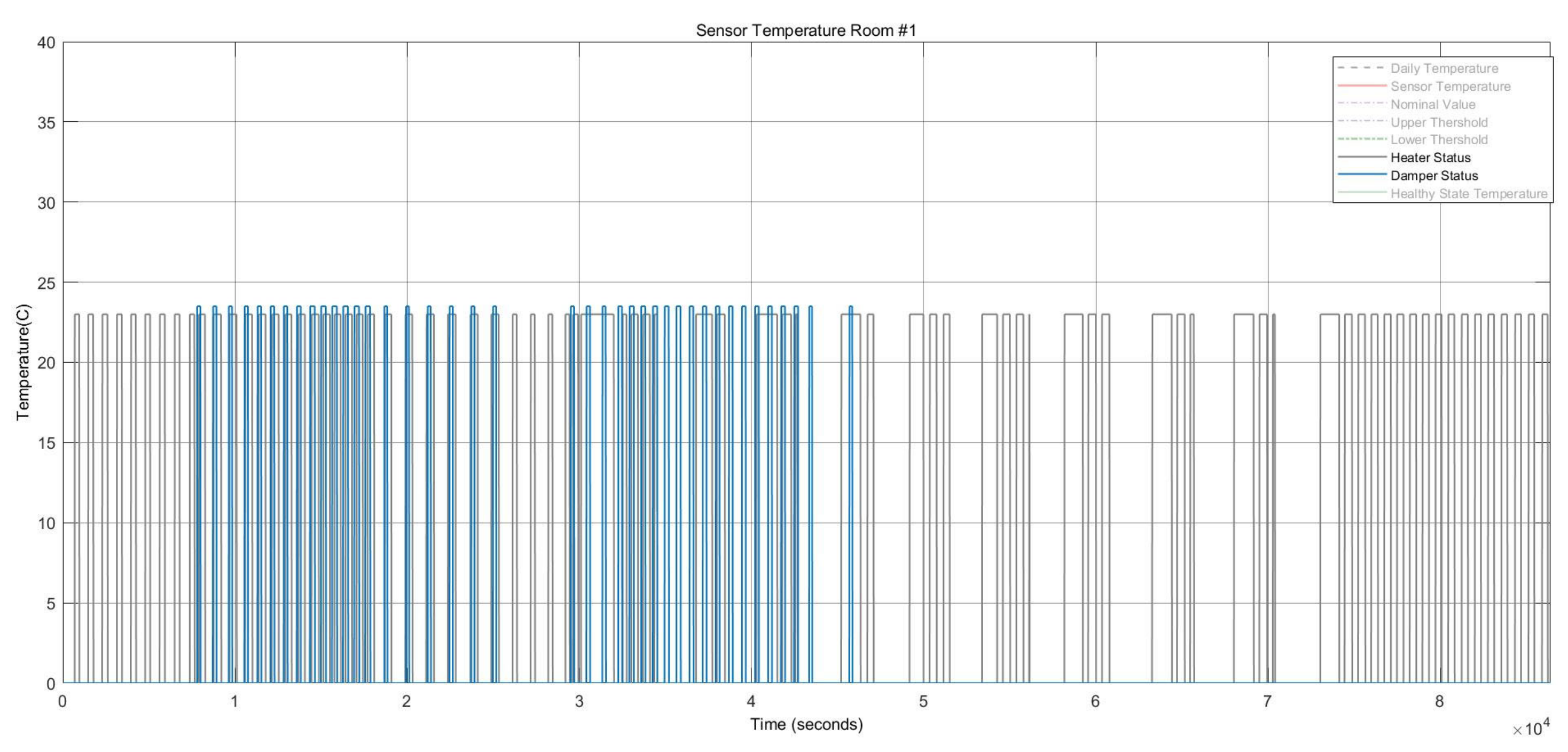
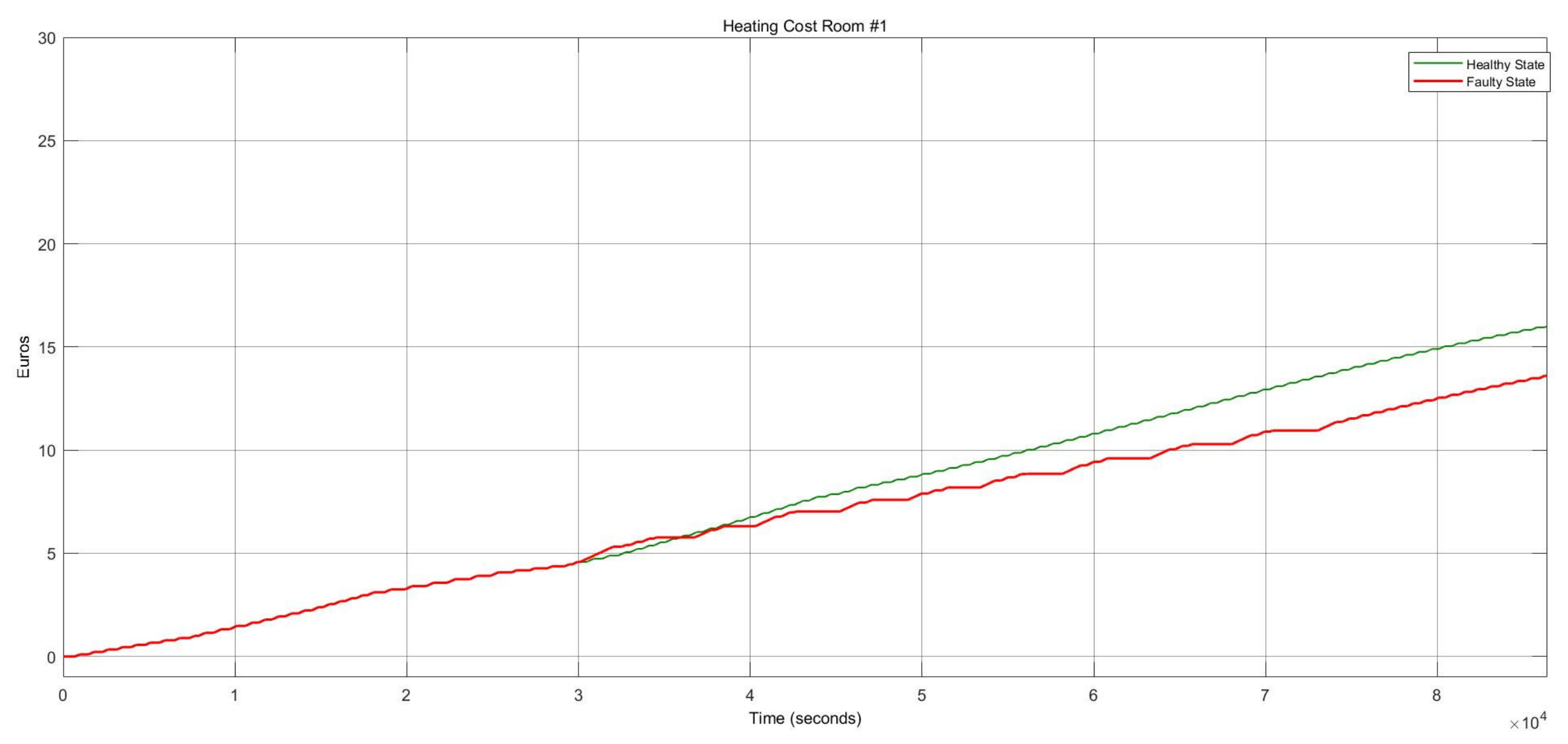
| Parameters (System Variables) | Values | Units |
|---|---|---|
| Optimal room temperature | 20 | °C |
| Optimal CO2 concentration | 600 | ppm |
| Lower-threshold temperature | 17.5 | °C |
| Upper-threshold temperature | 22.5 | °C |
| Lower-threshold CO2 concentration | 400 | ppm |
| Upper-threshold CO2 concentration | 700 | ppm |
| Heater on status | 1 | - |
| Heater off status | 0 | - |
| Damper open status | 1 | - |
| Damper closed status | 0 | - |
| Nr. | Component Faults | Phases | Component Failure or System Fault | System Failure | Impacts |
|---|---|---|---|---|---|
| 1 | Wrong scheduling of the processing unit, e.g., an incorrect sequence of operations | Developmental fault: design fault | Stuck-at fault Gain fault Offset fault Out-of-bounds fault | Delay High/low/wrong sensor measurements | Equipment life Energy consumption Thermal comfort Indoor air quality |
| 2 | Programming mistakes | Developmental fault: design fault | Stuck-at fault Gain fault Offset fault Out-of-bounds fault | Delay High/low/wrong sensor measurements | Equipment life Energy consumption Thermal comfort Indoor air quality |
| 3 | Wrong setpoints too high/low | Developmental fault: design fault | Stuck-at fault Gain fault Offset fault Out-of-bounds fault | High/low/wrong temperature. High/low/wrong CO2 concentration | Equipment life. Occupant thermal comfort. Energy consumption |
| 4 | Oversized equipment at design phase, e.g., incorrect perimeter heating system sizing | Developmental fault: design fault | Stuck-at fault Gain fault Offset fault Out-of-bounds fault | High/low/wrong temperature. High/low/wrong CO2 concentration | Equipment life Occupant thermal comfort. Energy consumption |
| 5 | Improper design | Developmental fault: design fault | Stuck-at fault Gain fault Offset fault Out of bounds Data loss | Delay High/low/wrong sensor measurements | Equipment life Occupant thermal comfort. Energy consumption |
| 6 | Inaccurate location of sensors and valves, e.g., wrong thermostat location, Occupancy-sensor misplacement | Developmental fault: design fault | Stuck-at fault Gain fault Offset fault Out of bounds Data loss | Delay High/low/wrong sensor measurements | Equipment life. Occupant thermal comfort. Energy consumption |
| 7 | Missing insulation for ductwork or pipes | Developmental fault | Stuck-at fault Gain fault Offset fault | Delay High/low/wrong sensor measurements | Occupant thermal comfort. Indoor air quality |
| 8 | Poor coordination of the processing unit | Developmental fault | Stuck-at fault Gain fault Offset fault Out of bounds Data loss | Delay Missing information | Occupant thermal comfort. Indoor air quality Delay |
| 9 | Air-duct leakages | Operational faults | Stuck-at fault Gain fault Offset fault | Wrong actuator signals | Equipment life Thermal discomfort Indoor air quality Energy consumption |
| 10 | Inappropriate voltage | Operational faults | Stuck-at fault Gain fault Offset fault Out of bounds Data loss | Wrong actuator signals High/low/wrong sensor measurements Missing information | Equipment life Thermal discomfort Energy Consumption Life risk Fire risk |
| 11 | Poor preventive maintenance | Operational faults | Stuck-at fault Gain fault Offset fault Out of bounds Data loss | Delay Missing information | Equipment life Energy consumption Life risk Fire risk |
| Nr. | Component | System Faults | Average Presence of Faults in February | Average Monthly Presence of Faults Among the Total of 28 Faults | Total Monthly Probability | Total Daily Probability |
|---|---|---|---|---|---|---|
| 1 | Temperature Faults | Temperature sensor fault | 18% | 8% | 0.2538 | 0.0091 |
| Temperature frozen | 35% | |||||
| The mismatch between supply air temperature and its setpoint | 26% | |||||
| Supply air temperature abnormal | 12% | |||||
| Mix air temperature sensor fault | 4% | |||||
| Mix air temperature abnormal | 22% | |||||
| Return air temperature abnormal | 2% | |||||
| Setpoint fault | 4% | |||||
| Missed control optimization | 28% | |||||
| 2 | Heater Faults | Heater abnormality | 9% | 2% | 0.0324 | 0.001157 |
| Heating coil valve leakage | 2% | |||||
| Setpoint fault | 4% | |||||
| Missed control optimization | 28% | |||||
| 3 | CO2 Faults | Airflow sensors abnormalities (CO2 sensor) | 13% | 10% | 0.05785 | 0.00206 |
| Return airflow abnormal | 1.5% | |||||
| Return air CO2 sensor | 1% | |||||
| Missed control optimization | 28% | |||||
| Setpoint fault | 4% | |||||
| 4 | Damper Faults | Damper stuck | 8% | 11% | 0.0312 | 0.0028 |
| Missed control optimization | 28% |
| Fault_Case Obj1 | Fault_Case Obj2 | Fault_Case Obj | .. | Fault_Case Obji | .. | Fault_Case Obj n-1 | Fault_Case Objn |
| Nr. | Scenarios (Events) | Sub Scenarios (Sub Event) | Faulty Room | Faulty Components | Faults’ Attributes | Impacts | |||||
|---|---|---|---|---|---|---|---|---|---|---|---|
| Fault Persistence | First Fault Type | Second Fault Type | Fault Occurrence Probability | CO2 Concentration Changes (ppm) | Temperature Changes (°C) | Energy Changes | |||||
| 1 | 1 | 1 | 1 | Damper actuator | Intermittent | Stuck-at (open) | Stuck-at (closed) | 0.6258 | ↑ | − | ↑ |
| 2 | 2 | 4 | CO2 sensor | Permanent | Gain fault | − | 0.0225 | ↑ | ↓ | ↑ | |
| 3 | 2 | 1 | 2 | Temperature sensor | Permanent | Out of bounds | − | 0.0996 | − | ↓ | ↓ |
| 4 | 2 | 5 | Heater actuator | Intermittent | Stuck-at (on) | Stuck-at (off) | 0.2586 | − | ↑↓ | ↑ | |
| 5 | 3 | 1 | 4 | Damper actuator | Intermittent | Stuck-at (open) | Stuck-at (closed) | 0.6258 | ↓↑ | − | ↑ |
| 6 | 2 | 5 | Temperature sensor | Permanent | Out Of bounds | − | 0.0996 | − | ↑ | ↓ | |
| 7 | 3 | 5 | Heater actuator | Intermittent | Stuck-at (off) | Stuck-at (on) | 0.2586 | ||||
| 8 | 4 | 1 | 4 | CO2 sensor | Permanent | Offset fault | − | 0.0225 | ↑ | ↑↓ | ↑ |
| 9 | 2 | 4 | Heater actuator | Intermittent | Stuck-at (on) | Stuck-at (off) | 0.25856 | ||||
| 10 | 3 | 5 | CO2 sensor | Permanent | Offset fault | − | 0.0225 | ↑ | ↓ | ↑ | |
| 11 | 4 | 5 | Damper actuator | Intermittent | Stuck-at (open) | Stuck-at (open) | 0.6258 | ||||
| 12 | 5 | 1 | 1 | CO2 sensor | Permanent | Stuck-at | − | 0.0308 | ↓ | − | ↓ |
| 13 | 2 | 5 | Temperature sensor | Permanent | Out of bounds | − | 0.6258 | ↓ | ↑ | ↓ | |
| 14 | 3 | 5 | Damper actuator | Intermittent | Stuck-at (open) | Stuck-at (closed) | 0.0996 | ||||
Publisher’s Note: MDPI stays neutral with regard to jurisdictional claims in published maps and institutional affiliations. |
© 2022 by the authors. Licensee MDPI, Basel, Switzerland. This article is an open access article distributed under the terms and conditions of the Creative Commons Attribution (CC BY) license (https://creativecommons.org/licenses/by/4.0/).
Share and Cite
Kiamanesh, B.; Behravan, A.; Obermaisser, R. Fault Injection with Multiple Fault Patterns for Experimental Evaluation of Demand-Controlled Ventilation and Heating Systems. Sensors 2022, 22, 8180. https://doi.org/10.3390/s22218180
Kiamanesh B, Behravan A, Obermaisser R. Fault Injection with Multiple Fault Patterns for Experimental Evaluation of Demand-Controlled Ventilation and Heating Systems. Sensors. 2022; 22(21):8180. https://doi.org/10.3390/s22218180
Chicago/Turabian StyleKiamanesh, Bahareh, Ali Behravan, and Roman Obermaisser. 2022. "Fault Injection with Multiple Fault Patterns for Experimental Evaluation of Demand-Controlled Ventilation and Heating Systems" Sensors 22, no. 21: 8180. https://doi.org/10.3390/s22218180
APA StyleKiamanesh, B., Behravan, A., & Obermaisser, R. (2022). Fault Injection with Multiple Fault Patterns for Experimental Evaluation of Demand-Controlled Ventilation and Heating Systems. Sensors, 22(21), 8180. https://doi.org/10.3390/s22218180








